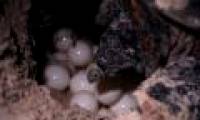
Giant tortoises in Galapagos, Australia's ruby sea arowanas or carnivorous plants in Brazil are listed among the 10 most prominent and impressive new species of 2016.

Archaeologists have found fossils of giant turtles living in South America 60 million years ago. This fossil was discovered at a coal mine in Colombia called Carbomemys Cofrinii,

Based on genetic data, scientists have identified a new species of

Leather or leatherback turtles - the largest sea turtle is at risk of extinction due to climate change. The turtle eggs are buried on hotter and drier beaches than before. This

On January 9, 2012, scientists said, the giant tortoise, Chelonoidis elephantopus, was discovered.

The Galapagos giant turtle and other typical wildlife are facing new diseases when the island's mosquitoes suddenly change the source of food to reptile blood.

The Galapagos Islands have a bizarre fauna with rare endemic animals of volcanic regions isolated on the Pacific Ocean. This is an archipelago of interest by many ecologists, in
 Giant tortoises in Galapagos, Australia's ruby sea arowanas or carnivorous plants in Brazil are listed among the 10 most prominent and impressive new species of 2016.
Giant tortoises in Galapagos, Australia's ruby sea arowanas or carnivorous plants in Brazil are listed among the 10 most prominent and impressive new species of 2016. Archaeologists have found fossils of giant turtles living in South America 60 million years ago. This fossil was discovered at a coal mine in Colombia called Carbomemys Cofrinii,
Archaeologists have found fossils of giant turtles living in South America 60 million years ago. This fossil was discovered at a coal mine in Colombia called Carbomemys Cofrinii, Based on genetic data, scientists have identified a new species of
Based on genetic data, scientists have identified a new species of Leather or leatherback turtles - the largest sea turtle is at risk of extinction due to climate change. The turtle eggs are buried on hotter and drier beaches than before. This
Leather or leatherback turtles - the largest sea turtle is at risk of extinction due to climate change. The turtle eggs are buried on hotter and drier beaches than before. This On January 9, 2012, scientists said, the giant tortoise, Chelonoidis elephantopus, was discovered.
On January 9, 2012, scientists said, the giant tortoise, Chelonoidis elephantopus, was discovered. The Galapagos giant turtle and other typical wildlife are facing new diseases when the island's mosquitoes suddenly change the source of food to reptile blood.
The Galapagos giant turtle and other typical wildlife are facing new diseases when the island's mosquitoes suddenly change the source of food to reptile blood. The Galapagos Islands have a bizarre fauna with rare endemic animals of volcanic regions isolated on the Pacific Ocean. This is an archipelago of interest by many ecologists, in
The Galapagos Islands have a bizarre fauna with rare endemic animals of volcanic regions isolated on the Pacific Ocean. This is an archipelago of interest by many ecologists, in






 Why did the ancient Babylonian civilization perish? Was it because they considered 'that thing' a daily meal?
Why did the ancient Babylonian civilization perish? Was it because they considered 'that thing' a daily meal? Just discovered a 72km 'tear in the Earth', the world's second largest country is in fear of a tsunami attack
Just discovered a 72km 'tear in the Earth', the world's second largest country is in fear of a tsunami attack Top 7 facts about the hottest place in the world, where you can fry eggs at outdoor temperature
Top 7 facts about the hottest place in the world, where you can fry eggs at outdoor temperature The Qing Dynasty collapsed, what surname did 20,000 royal descendants change to to integrate into the new era?
The Qing Dynasty collapsed, what surname did 20,000 royal descendants change to to integrate into the new era? After 389 days in the Arctic, costing more than $160 million, hundreds of scientists brought back bad news: What was it?
After 389 days in the Arctic, costing more than $160 million, hundreds of scientists brought back bad news: What was it? How long does it take to fall in love with someone?
How long does it take to fall in love with someone? How much silver has ever been discovered in the world?
How much silver has ever been discovered in the world? How does an atomic bomb work?
How does an atomic bomb work?